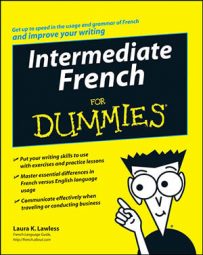Learning the correct object pronoun word order and identifying verbs that use être as their auxiliary verb will boost your confidence when speaking French.
Categorizing French articles
In French, there are three kinds of articles (small words you can only use with nouns): definite, indefinite, and partitive. The purpose of an article is to present a noun and indicate its gender and number.
This chart represents articles and how to use them in French writing and language:
| Gender/Number | Definite (the) | Indefinite (a, an, some) | Partitive (some, any) |
|---|---|---|---|
| Masculine singular | le | un | du |
| feminine singular | la | une | de la |
| plural | les | des | des |
French contractions with à and de
The most common French prepositions are à (to, at, in) and de (of, from, about). When these two prepositions are followed by the definite articles le and les, a contraction needs to be formed. (Note: There’s no contraction with à or de plus la or l’: à la, à l’, de la, de l’.)
| Article | à + (le/les) | de + (le/les) |
|---|---|---|
| Le | au | du |
| Les | aux | des |
À and de also contract with the different forms of lequel (which one):
| Form of Lequel | à + (lequel) | de + (lequel) |
|---|---|---|
| Lequel | auquel | duquel |
| Lesquels | auxquels | desquels |
| Lesquelles | auxquelles | desquelles |
There’s no contraction with laquelle: à laquelle, de laquelle.
French personal pronouns
Simply put, pronouns replace nouns. Pronouns refer to people, places, things, and ideas, without having to use the same nouns over and over. The French language uses five types of personal pronouns. These French pronouns are the equivalents to I/me, you, or he/him/it:
| Person | Subject Pronoun | Direct Object Pronoun | Indirect Object Pronoun | Reflexive Pronoun |
|---|---|---|---|---|
| 1st person singular | je | me | me | me |
| 2nd person singular | tu | te | te | te |
| 3rd person singular (masc.) | il | le | lui | se |
| 3rd person singular (fem.) | ell | la | lui | se |
| 1st person plural | nous | nous | nous | nous |
| 2nd person plural | vous | vous | vous | vous |
| 3rd person plural | ils, elles | les | leur | se |
Object pronoun word order in French
To effectively use French object pronouns, you need to understand what they mean and where they go in the sentence. In the affirmative imperative, direct-object pronouns (like reflexive pronouns) follow the verb and are attached to it with hyphens; in addition, me changes to moi and te changes to toi. This chart shows the object pronoun word order with the affirmative imperative (command):
| Direct Object (3rd Person) | Direct Object (1st or 2nd Person) or Reflexive Pronoun | Y (there — refers to place) | En (some, any, of them) |
|---|---|---|---|
| Le | moi | y | en |
| La | toi | ||
| Les | lui | ||
| nous | |||
| vous | |||
| leur |
Here’s the word order with everything else, including the negative imperative:
| Reflexive Pronoun, Direct Object (1st or 2nd Person), or Indirect Object (1st or 2nd Person) |
Direct Object (3rd Person) | Indirect Object (3rd Person) | Y (there — refers to place) | En (some, any, of them) |
|---|---|---|---|---|
| me | le | lui | y | en |
| te | la | leur | ||
| se | les | |||
| nous | ||||
| vous |
Recognizing être verbs in French
In French, the passé compose is a compound verb tense, meaning it has two parts: an auxiliary verb and a past participle. French has two auxiliary verbs, avoir or être, and most main verbs use avoir.
Memorize the following short list of verbs, which refer to coming and going (both literally and figuratively) that use être:
-
aller (to go)
-
arriver (to arrive)
-
descendre (to descend )
-
entrer (to enter )
-
monter (to climb)
-
mourir (to die)
-
naître (to be born)
-
partir (to leave)
-
passer (to pass [by, in front of, behind] )
-
rester (to stay )
-
retourner (to return)
-
sortir (to go out )
-
tomber (to fall )
-
venir (to come)
In addition, pronominal verbs use être: je me suis levé (I got up.)

